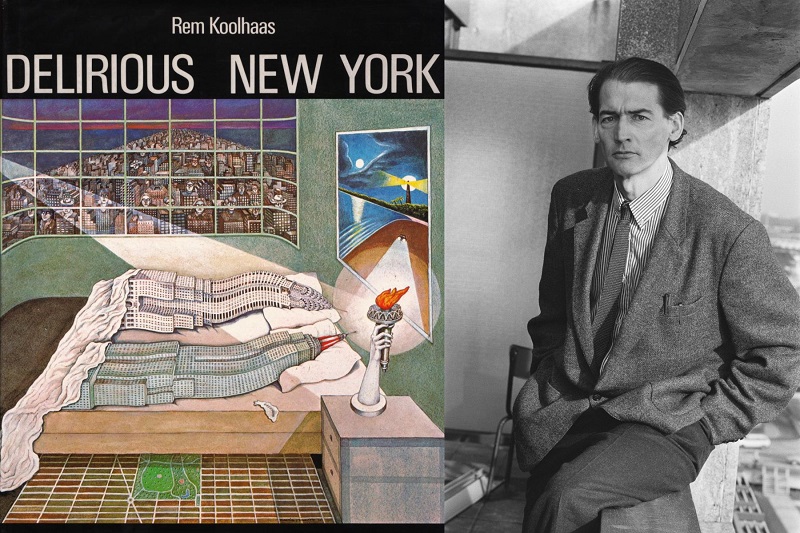ISABEL RUBIO ARROYO | Tungsteno
Rem Koolhaas worked as a journalist before becoming an architect. Known for his provocative style, he went on to become one of the world's most influential architects. So much so that he was awarded the prestigious Pritzker Prize in 2000. His most famous works include the headquarters of China Central Television in Beijing and the Prada Foundation in Milan. But he is most famous for his book Delirious New York: A Retroactive Manifesto for Manhattan, which outlines his perspective on the chaos and vitality of this city.
The book that catapulted Koolhaas to fame
Koolhaas' writings made him famous in the field of architecture before he had completed a single building, as the organisers of the Pritzker Prize note. The Rotterdam-born architect, who spent four years of his youth in Indonesia, was a journalist in the 1960s. After graduating from the London School of Architecture Association in 1972, he received a scholarship to travel and research in the United States. It was there that he wrote Delirious New York, hailed by critics as a classic text on modern architecture and society.
In this book, Koolhaas examines New York as a metaphor for the diversity of human behaviour. In the late 19th century, the explosion of population, technology and information transformed Manhattan into a laboratory for the invention and testing of a new way of life: the culture of congestion. This culture, he says, is reflected in the city's architecture. "Manhattan," writes Koolhass, "is the 20th century’s Rosetta Stone… occupied by architectural mutations (Central Park, the Skyscraper), utopian fragments (Rockefeller Center, the UN Building) and irrational phenomena (Radio City Music Hall)…"
New York City today is a metropolis full of contrasts. Credit: Pxhere
The Chrysler Building sleeps with the Empire State Building
The iconic cover image of the first edition of this book shows the Empire State Building and the Chrysler Building lying in the same bed. This symbolic image captures the essence of the architect's approach to New York City, presenting a provocative and playful vision of architecture and urbanism. When Koolhaas wrote it, the city was in a spiral of violence and decay. But he saw it as a potential urban paradise. "It was geared against this idea of New York as a hopeless case," Koolhaas told Smithsonian magazine. "The more implausible it seemed to be defending it, the more exciting it was to write about."
The book explores in depth the chaos and complexity of New York as a constantly evolving metropolis. Although the first skyscrapers were built in Chicago, Koolhaas argues that New York became the true epicentre of urban modernity. Some critics have accused the architect of celebrating Manhattan’s congestion and lack of urban planning. His defenders argue that his analysis seeks to highlight the complexity and vitality of urban life. Today, Koolhaas' view of New York has changed. "I no longer see New York as a physical reality, but as the epicentre of certain values that I don't feel at all close to," he told Icon Design in 2023.
The architect's legacy
In 1975, Koolhaas founded the Office for Metropolitan Architecture (OMA) in London, a practice that focused on contemporary design. The firm won a competition to expand the parliament building in The Hague and a major commission to develop a master plan for a residential district in Amsterdam. Years later, the architect was commissioned to design and build the Netherlands Dance Theatre.
His most iconic works include the Austrian House, the Taipei Performing Arts Centre, the Qatar National Library and Qatar Foundation Headquarters, the Galeries Lafayette Foundation in Paris, the Prada Foundation in Milan, the China Central Television Headquarters in Beijing and the Seattle Central Library. He also published the mammoth book S, M, L, XL in 1995. In it, he summarised OMA's work in what he called a "novel about architecture," which includes thoughts, plans, photographs, essays and writings of fiction.
The headquarters of China Central Television in Beijing is the work of architects Rem Koolhaas and Ole Scheeren. Credit: Wikimedia Commons
Despite the success of Delirious New York and his long career as an architect, Koolhass, 79, says he has never had it easy: "We have never been able to turn clients away. We've never had that moment of guaranteed peace of mind. And I think it's because, as well as bringing an interest in architecture, we were at the same time imparting criticism, which made our approach less attractive to many clients. We probably scared off as many as we attracted," he says.
Tungsteno is a journalism laboratory to scan the essence of innovation.
